I wrote the following artical as a brief trip report about our trip to the sunstone mines in southern Oregon, USA. This artical was also published in the June 2011 Issue of Rock and Gem Magazine.
We fell in love with sunstones as soon as we discovered them and now often feature them as well as sunstone jewelry on our website. You can see what we currently have in stock here!
Your Next Big Trip: Sunstones!

Our Sunstone mining trip actually began many months before we actually set off down the road in our trusty pick up. The story begins at the Snyder Ranch Rock Show in Valley Springs, CA. Shasta, and I had journeyed there to visit a friend at his local mining claim, and also to take part in the rock show. Of the many booths, the one that captured our attention was the sunstone booth. Run by Dave and Tammy, who own their own claim in Oregon, the booth was filled to the brim with sunstones! this was the first that we had seen these amazing stones. For those not familiar, sunstones come from three main locations: Tvedestrand in southern Norway, Tanzania, Africa, and Oregon, USA. They are a type of feldspar containing red hematite and copper which produces schiller! Tanzanian sunstones have what is called "confetti" schiller, which looks exactly what it sounds like. Oregon sunstones have more wispy, copper hued schiller, which runs in parallel planes, creating a shimmer in the stone, as if it glowed within. These Oregon sunstones are what now had us glued to this booth for the better part of an hour.
On the Drive back to our home, we each talked about the show, our finds, the people watching, and the good deals that we had discovered. But the conversation kept veering back to the sunstones and the mines in southern Oregon. Not that far from our home in Central California... It wasn't long before Shasta declared that we were going to take a trip up there to see the mines four ourselves and that was the end of that!
We planned our trip so that it would coincide with the fourth of July weekend Pow-Wow rock show in Madras and the Sisters Rock show, which occurred during the same weekend, in the town for which it was named. Sisters and Madras are in Central Oregon, about an hour from Bend, and only about 45 minutes from each other. They are also about 8 hours from the Town of Plush, which is the nearest town to the sunstone mines. The Drive is long, and involved several stops on the way for sleeping, eating and refueling so make sure to plan accordingly. With good planning, you can stop at any number of scenic locations, rock hounding areas or other road side attractions along the way. We stopped and slept the first night in Folsom, CA and the following day, bright and early, made out for Plush, OR. There is a gas station there, but if you need any supplies I recommend stopping in Lakeview as well since Plush does not have a store. You should fill up your vehicle in Plush though as it is a long haul out to the next city as I will explain later. Do take the time to take in the scenic surroundings along the way. The road between Lakeview and Plush is full of these vista opportunities between the breaks in trees... Okay, okay... there are in fact, zero trees, for miles, but this in itself is a rather amazing spectacle.
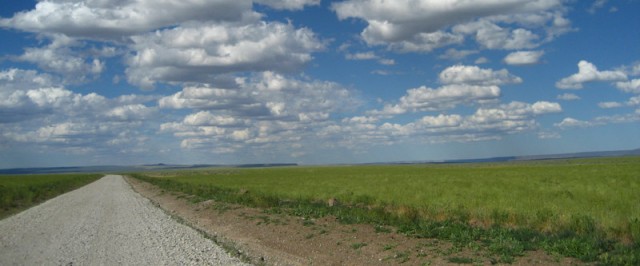
We followed the directions given on the Dust Devil Sunstone Mine Website which gave very precise mileages and turn indications. This is important out there as there are a lot of back roads and very little in terms of street signs. The road is partly paved and then becomes a well graded dirt road, suitable for car and truck alike. We had decided ahead of time which of the mines that we wanted to go to based on advice from people that we had met at the Valley Springs Rock Pow-Wow. However, there are several commercial digs in the area so feel free to do some research to determine what works best for you.
We arrived late in the afternoon, the sun already starting to get low in the sky. Co-owner Don Bufordcame out to meet us when we arrived. I had talked to him on the phone about a month prior and he remembered me. Don keeps several camping trailers on site for visitors to stay in free of charge during their visit and I had reserved one of them. By that time the sun was in the perfect position for walking back and forth along the drive way, watching for the flash of rough sunstone. Since they have paved their driveway in the crushed tailings of the mine the driveway is more or less paved in sunstone! It was not long before we were itching to get to digging so Don showed us the spot to start at and we went to work for the next few hours with picks, small shovels and rock hammers. Unlike some fee digging places, at this mine you actually get to dig virgin ground at a chance to really make a big find, not just sift through the left over tailings, or go through buckets brought up from a mine. The layout is an open pit style mining operation. We had been shown a spot where the over burden had been removed by a large excavator and where hopefully, sunstones lay just under our feet.
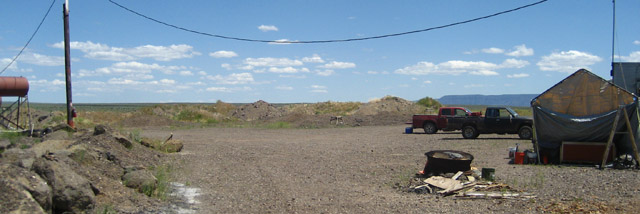
Sunstones formed in pockets the basalt rock, usually concentrated at a certain layer in the ground, and so extracting the shinny little gems requires a bit of brute strength and some finesse, plus a touch of luck. These layers were formed by ancient lava flows and so they are usually not perfectly flat or straight. The most common method is to break up the host rock with hammers and picks, load the resulting gravel and small stones into a large sieve and start shaking. This worked well for the two of us. While I was busy making a small dent in the earth with my tiny rock hammer, Shasta screened the rocks and picked out the goodies. Don was even nice enough to loan us a 1/4" and 1/2" screen and a roller. The roller was made of two saw horses, with rolling wheels mounted between them. The screens could then be set on top and easily shaken back and forth. Sounds simple enough but it was not long before we were both pooped and it was time for dinner.
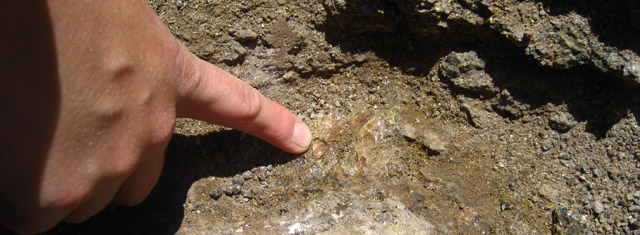
We had a full set of camping equipment and cook wear and had brought some food to prepare but before we had a chance to wash up, Don and his daughter had invited us over to their trailer to partake in their meal. Over a hearty meal of potatoes, pasta salad and carrots we chatted about rocks, and Don told us the history of the mine, about the local folk lore and a plethora of other rock hounding stories and anecdotes. This turned out for the best since after the sun goes down there is really nothing to do out here. A short while later another couple arrived. They had been there the day before but had been out for the day and were now just returning. They had come all the way from Canada, and were here for the second time. One of them wore a beautiful peach schiller sunstone pendant, made from a single solid sunstone, at least 40 carats in size, with a hole drilled at the top for a thin chain to pass through. She related that she had mined the stone herself a few years ago and had had it cut and polished and now hopefully it would bring her luck once again.
The next morning, Don took pity on me and my wimpy little rock hammer and loaned us his electric jack hammer for use in the pit to break up the stubborn rocks. I lugged the heavy hammer and the accompanying gasoline driven generator down to the pit were we had been digging the night before. It was not long before the rock was crumbling beneath my powerful new toy and the buckets of screening material were stacking up. Soon we hit pay dirt! When we reached the right level in the earth, the basalt started to yield little pockets of sunstone. It seemed like everywhere you looked was a little crystal! We continued with a new strategy: First we would break up a 2" deep layer of earth, the rocks would then be handpicked over and then the resulting new bottom would be brushed with a whisk broom. Often times we would stumble upon large pockets of sunstone right there on the surface. I would then hammer all around the pocket and we would pull out the piece whole. The sunstones would then be carefully dislodged with a small hand tools like a screwdriver or small rock pick.
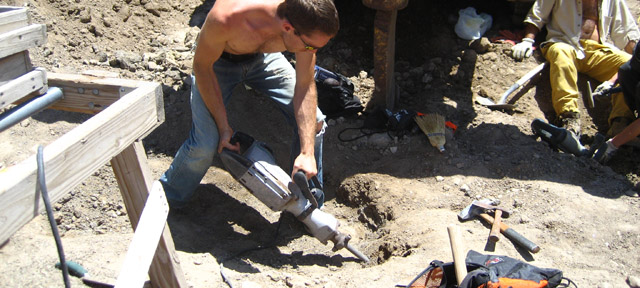
Most of the piece we found were very small, no larger than a pea and clear with little to no schiller or color. But every so often I would hear a little whoop from Shasta, as she brushed off a winner and held it up to the light. We'd spend the next few minutes admiring our find and then it was back to digging, hoping for more! This continued on through lunch and into the early afternoon. It would have been much harder to put our shovels down had it not been such backbreaking work. We carried the equipment back up to the office and sat down with Don to go over our finds. We had done fair, finding hundreds of tiny sunstones, and a fair number of larger ones with bars of schiller gracing their surface. We paid Don for our finds (you only pay for what you find and want to keep) and packed up the truck. Before leaving we also took the time to look around the small shop that was set up. Inside were various faceted and cabbed sunstones, rough and sunstone carvings for sale. It was now mid afternoon, we were in the middle of nowhere and we still had a rockhounding stop on the way to our campsite, several hundred miles away.

A few things we learned on our trip: Sunstone is a type of feldspar, which makes them related to Amazonite, Andesine, Moonstone, Labradorite, Oligoclase, Orthoclase and Sanidine. Due to its schiller effect, sunstone is sometimes referred to as aventurine-feldspar. Heliolite is the Greek word for Sunstone. This name is often used to describe sunstone but more often is used to describe feldspar in general since many types of feldspar exhibit some type of colorful effect, such as labradorite and moonstone. Clear sunstones are the most common, followed by straw colors, peach, red, green, teal and blue. The schiller effect in the stone is one of only a few inclusions in the gemstone world which is considered to add value to a stone rather than subtract from it. The schiller in sunstones runs along the natural planes in the stone which means it is often only visible from certain viewpoints. The sunstone claims in Plush, OR were originally owned by Tiffany and Co. and were sold off in the late 1980's. Tiffany and Co. originally marketed them as "Plush Diamonds", however, the popularity never caught on and the company invested little in pushing the material commercially. Even now, 20 years later, sunstones are still not widely known. After all we had not ever heard of these stones until we discovered them ourselves just a year ago.
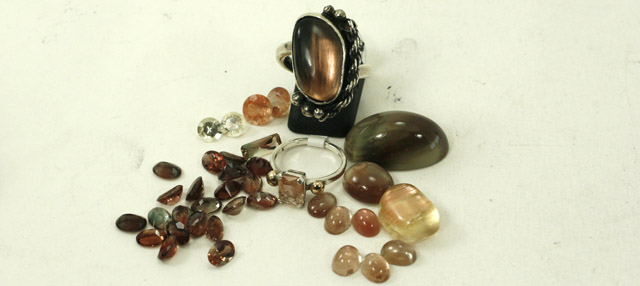
Our trip continued on for another week and included a stop at Blass butte to hunt for obsidian. There was an afternoon of rock climbing for me at the famous Smith Rock. We went to Richardson's Ranch and dug fro thunder eggs, even getting a chance to dig in their Priday Plume Agate bed which are only open during the weekend of the Madras show. We also had the chance to go to the Madras Rock show as well as the Sisters rock show. Two shows in one weekend! On the Way home we even paused at an abandoned copper mine on the flanks of mount Shasta. Mentioned in out Gem Trails book as having malachite and Chrysocolla, here we were able to find several good piece which I later cut into caboshons. All this in conjunction with the sunstone mine made this a rock hound trip of a life time.
You can find our hand made sunstone jewelry for sale here on this webside just by searching for "Sunstone" in our search bar.
Enjoy!
Cheers,
Austin and Shasta
